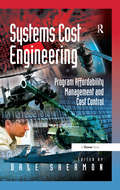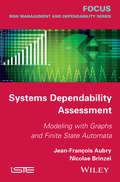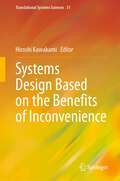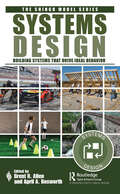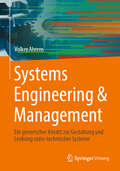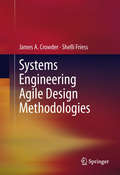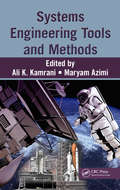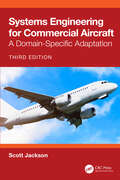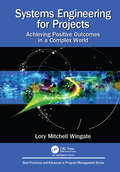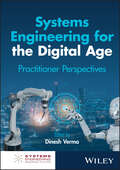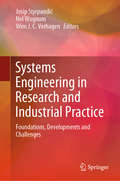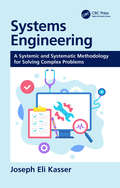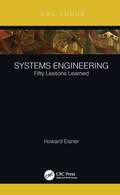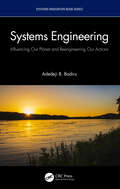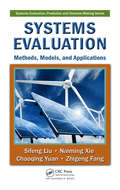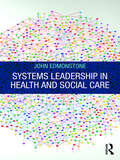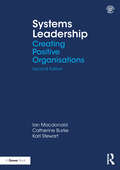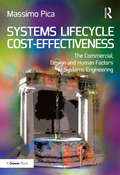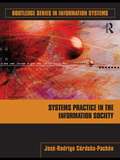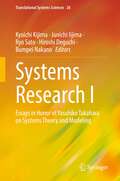- Table View
- List View
Systems Cost Engineering: Program Affordability Management and Cost Control
by Dale ShermonParametric cost estimating models are flexible tools which bring engineering, scientific and mathematical rigour to cost and schedule estimating, but great tools alone will not keep programs affordable. Tools must be applied as part of a credible process if estimates and analyses are to be accepted. Complex major projects involving engineering, hardware, software, service and IT, all suffer from two basic problems: the project sponsors often struggle to specify the project effectively, and project managers find themselves wrestling with unpredicted cost or schedule overruns. Everyone wants to be successful with the tools and solutions they use, so this book is a comprehensive collection of methods with proven success. The applications described by Dale Shermon and his co-authors have evolved over 30 years of cost engineering experience during which time they have been matured by the parametric community. Each chapter explores a different application of parametrics, based on real-life case examples, providing you with a detailed guide to the rationale and value of cost engineering in a different industry or program context. Systems Cost Engineering will help cost engineers, project and program directors, and the champions that support them, to understand and apply parametrics to ensure that their programs: * offer a credible analysis of alternative cost options * are never initiated with insufficient funding because of inaccurate estimates of cost or quantification of risks * are never diverted from their objective because of a lack of credible cost management * share and communicate knowledge of realistic and dynamic cost and productivity metrics amongst the program team * are never derailed by surprise cost overruns or schedule delays The information in this book will give projects sponsors and bid managers confidence in the business case that they are developing and enable them to communicate a clear and transparent picture of the risks, opportunities and benefits to stakeholders and project owners.
Systems Dependability Assessment
by Nicolae Brinzei Jean-Fran?ois AubryPresents recent developments of probabilistic assessment of systems dependability based on stochastic models, including graph theory, finite state automaton and language theory, for both dynamic and hybrid contexts.ons are presented.
Systems Design Based on the Benefits of Inconvenience (Translational Systems Sciences #31)
by Hiroshi KawakamiThis book is about the "benefits of inconvenience (BoI)", providing a new approach to designing innovative systems and opening an alternative viewpoint to readers for looking at the world. BoI says that convenient living has “black boxed” the processes we used to rely on, while BoI is about looking at the benefits that were originally provided by these actions that have been black-boxed. Consider the relationship between humans and artificial objects, or things, newly created by engineering technology. In the past, things were “extensions” of people, but before we knew it, things began to substitute for people. BoI can be a keyword for thinking about the relationship that should come after “substitution”. It is a principle of systems design, one that requires time and effort rather than being convenient without any bother. Leading system scientists, technology creators, service producers, and product designers have contributed to this volume. In the first half of the book, many researchers describe their theory of BoI from the perspectives of systems engineers, value engineers, designers, and innovators. In the second half of the book, examples of implementing BoI are introduced in various fields, such as product design, service design, social robotics, tourism engineering, and human activity support systems. They will support innovations in systems or services. It is generally said that necessity is the mother of invention. In that belief, inconveniences should be eliminated, which can be a motive force for new technological development. On the other hand, this book shows that inconveniences are not something to be eliminated, but, on the contrary, are essential to obtain some benefit, and shows us how to create beneficial inconveniences.
Systems Design West
by Richard S. Ruback Royce YudkoffJenn Braus (HBS 2013) was half-way through the 90-day exclusivity period for her proposed acquisition of Systems Design West ("SDW"). She had completed her business and accounting due diligence. Just as she was about to ask her lawyer to begin drafting the purchase agreement, she received a call from the seller that the company had reached agreement with a large new client that would increase revenue by roughly 20%. The seller asked that the success be reflected in an increased offer price, although he had not specified the amount of the increase. Braus needed to decide on an appropriate response. Should she stand fast? In her mind, she had already agreed to pay a premium price for SDW, with a higher than typical multiple of EBITDA. Part of her rationale for the high multiple was that she believed the company had significant growth potential. Paying a higher price in response to the new customer seemed like paying twice for the growth. However, because the new customer was so large, Braus imagined that it would nudge the run rate EBITDA for SDW to about $1 million, eliminating a concern she had about the small size of the business. If she decided to negotiate a higher price, how much an increase was appropriate? Simply applying historical margins would imply that a 20% increase in revenue would correspond to a 20% increase in price. Alternatively, it could be more as margins improved with operating leverage or it could be less if significant fixed costs were required to on-board the new customer. Additionally, Braus was concerned that a new customer was inherently riskier than SDW's typical customer that had a history of recurring revenue.
Systems Design: Building Systems that Drive Ideal Behavior (The Shingo Model Series)
by Brent R. Allen and April A. BosworthThe ground-breaking Shingo Model of 2008 introduced principles, systems, tools, and results. At that time, however, the systems element of the model did not receive the in-depth attention that other parts of the model did. As a result, organizations developed their own concept of systems. Some organizations have identified hundreds of systems and tools. In fact, the distinction between a system and a tool was not clearly defined until recently with the introduction of the Shingo SYSTEMS DESIGN workshop and the information discussed in this book. With the development of the workshop, the Shingo Institute is now teaching the three essential systems—work, improvement, and management—as well as the five required communication tools that are necessary to improve an organization. You’ll find that when these systems are formalized, they work together to help create organizational excellence. With Systems Design: Building Systems that Drive Ideal Behavior you’ll learn how to formalize the process of creating these three systems. In addition, a new tool, the Shingo system design map, is introduced. This book also details how you can improve the connections you’ve already made between the tools, systems, results, and principles of the Shingo Model.
Systems Engineering & Management: Ein generischer Ansatz zur Gestaltung und Lenkung sozio-technischer Systeme
by Volker AhrensDieses Buch zeigt Schritt für Schritt, wie man technische Systeme effizient und effektiv entwickelt, realisiert (Engineering) und betreibt (Administration). Dazu wird zunächst erklärt, wie komplexe reale Systeme vereinfacht, also modelliert werden, um ihre relevanten Eigenschaften sichtbar zu machen. Dies erfolgt interdisziplinär, indem neben technologischen auch soziologische und psychologische Aspekte berücksichtigt werden. Anschließend werden fünf allgemeingültige Vorgehensmodelle erläutert, die ausreichen, um Systeme in allen ihren Lebensphasen zu gestalten und zu lenken. Schließlich wird der Problemlösungszyklus im Detail erläutert. Für jede Phase einer Entwicklung wird erklärt, was wann, warum und wie getan werden sollte, um das Vorhaben erfolgreich abzuschließen. Ergänzend werden Bezüge zum Projektmanagement hergestellt. Alle erläuterten Modelle, Methoden, Verfahren und Werkzeuge haben sich in der Praxis schon vielfach bewährt. Daher eignet sich das Buch als Leitfaden für Praktiker*innen und für die akademische Lehre. Vor allem diejenigen, die nicht nur wissen wollen, was sie tun sollen, sondern auch verstehen wollen, warum das eine besser funktioniert als das andere, werden nicht nur entsprechende Erklärungen finden, sondern darüber hinaus auch zahlreiche Anregungen, die zum konstruktiv-kritischen Weiterdenken verleiten und Innovation ermöglichen.
Systems Engineering Agile Design Methodologies
by James A. Crowder Shelli FriessThis book examines the paradigm of the engineering design process. The author discusses agile systems and engineering design. The book captures the entire design process (function bases), context, and requirements to affect real reuse. It provides a methodology for an engineering design process foundation for modern and future systems design. Captures design patterns with context for actual Systems Engineering Design Reuse and contains a new paradigm in Design Knowledge Management.
Systems Engineering Tools and Methods (Engineering and Management Innovation)
by Ali K. Kamrani Maryam AzimiWaste, inadequate system performance, cost overruns, and schedule problems often result from failure to apply advanced systems engineering early in project development. Systems engineering is a systematic method to manage the formulation, analysis, and interpretation of what a system will produce and whether the outcome is the one that is desired. This book provides detailed discussions on engineering design and management processes within system lifecycles. The text addresses various issues of systems engineering fundamentals, emphasizing an integrated approach. The author presents methods, frameworks, techniques and tools for designing, implementing, and managing large-scale systems.
Systems Engineering for Commercial Aircraft: A Domain-Specific Adaptation
by Scott JacksonThe key principle of systems engineering is that an aircraft should be considered as a whole and not as a collection of parts. Another principle is that the requirements for the aircraft and its subsystems emanate from a logical set of organized functions and from economic or customer-oriented requirements as well as the regulatory requirements for certification. The resulting process promises to synthesize and validate the design of aircraft which are higher in quality, better meet customer requirements and are most economical to operate. This book is more of a how to and a why to rather than a what to guide. It stresses systems engineering is an integrated technical-managerial process that can be adapted without sacrificing quality in which risk handling and management is a major part. It explains that the systems view applies to both the aircraft and the entire air transport system. The book emphasizes that system engineering is not an added layer of processes on top of the existing design processes; it is the glue that holds all the other processes together. The readership includes the aircraft industry, suppliers and regulatory communities, especially technical, program and procurement managers; systems, design and specialty engineers (human factors, reliability, safety, etc.); students of aeronautical and systems engineering and technical management; and government agencies such as FAA and JAA.
Systems Engineering for Commercial Aircraft: A Domain-Specific Adaptation
by Scott JacksonSystems-engineered aircraft are designed to transport passengers safely, ensuring all components work together seamlessly. This book explores the concept of aircraft as a complex system, including humans, with safety as a crucial aspect. By prioritizing safety and quality, fewer fatalities can be achieved, leading to efficient, reliable, and safe aircraft for passengers and crew.Systems Engineering for Commercial Aircraft: A Domain-Specific Adaptation, Third Edition focuses on Deming's definition of quality, its methods, and the benefits it brings, which were not covered in the previous edition. The Risk chapter will also be expanded to include discussions on Risk Denial, its consequences, and strategies to avoid it. A detailed examination of resilience will be provided, highlighting how it enables an aircraft to prevent, endure, and recover from disruptions such as bird strikes. The book will explore the proactive and reactive aspects of resilience, how a system, like an aircraft, can be defined by its functions, and how an aircraft's design should prioritize the needs of various stakeholders, including passengers, regulatory agencies, and other relevant parties.The primary audience for this book consists of major aircraft companies engaged in advanced design, aeronautical engineers, and systems engineers.
Systems Engineering for Projects: Achieving Positive Outcomes in a Complex World (Best Practices in Portfolio, Program, and Project Management)
by Lory Mitchell WingateSystems engineering has been applied to some of the most important projects of our time, including those that have helped humanity explore the world and the universe, expand our technical abilities, and enhance the quality of human life. Without formal training in systems engineering, the discipline is often difficult to understand and apply, and its use within projects is often confusing. Systems Engineering for Projects: Achieving Positive Outcomes in a Complex World provides an approach that utilizes a combination of the most effective processes from both project management and systems engineering disciplines in a simplified and straightforward manner. The processes described in the book are lightweight, flexible, and tailorable. They provide the shortest path to success in projects across the entire project life cycle, from research to operations, and from simple to the most complex. The book also addresses how this methodology can be used in a continually adapting and changing world, as projects span disciplines and become even more interconnected across all areas of human existence. Each chapter includes diagrams, templates, summary lists, a case study, and a thought-provoking question and answer section that assists readers in immediate application of the material to their own projects. The book is a project manager’s resource for understanding how to directly apply essential processes to projects in a way that increases the probability of achieving success. It is a comprehensive, go-to manual on the application of systems engineering processes to projects of all types and complexity.
Systems Engineering for the Digital Age: Practitioner Perspectives
by Dinesh VermaSystems Engineering for the Digital Age Comprehensive resource presenting methods, processes, and tools relating to the digital and model-based transformation from both technical and management views Systems Engineering for the Digital Age: Practitioner Perspectives covers methods and tools that are made possible by the latest developments in computational modeling, descriptive modeling languages, semantic web technologies, and describes how they can be integrated into existing systems engineering practice, how best to manage their use, and how to help train and educate systems engineers of today and the future. This book explains how digital models can be leveraged for enhancing engineering trades, systems risk and maturity, and the design of safe, secure, and resilient systems, providing an update on the methods, processes, and tools to synthesize, analyze, and make decisions in management, mission engineering, and system of systems. Composed of nine chapters, the book covers digital and model-based methods, digital engineering, agile systems engineering, improving system risk, and more, representing the latest insights from research in topics related to systems engineering for complicated and complex systems and system-of-systems. Based on validated research conducted via the Systems Engineering Research Center (SERC), this book provides the reader a set of pragmatic concepts, methods, models, methodologies, and tools to aid the development of digital engineering capability within their organization. Systems Engineering for the Digital Age: Practitioner Perspectives includes information on: Fundamentals of digital engineering, graphical concept of operations, and mission and systems engineering methods Transforming systems engineering through integrating M&S and digital thread, and interactive model centric systems engineering The OODA loop of value creation, digital engineering measures, and model and data verification and validation Digital engineering testbed, transformation, and implications on decision making processes, and architecting tradespace analysis in a digital engineering environment Expedited systems engineering for rapid capability and learning, and agile systems engineering framework Based on results and insights from a research center and providing highly comprehensive coverage of the subject, Systems Engineering for the Digital Age: Practitioner Perspectives is written specifically for practicing engineers, program managers, and enterprise leadership, along with graduate students in related programs of study.
Systems Engineering in Research and Industrial Practice: Foundations, Developments and Challenges
by Josip Stjepandić Nel Wognum Wim J. C. VerhagenThis book details the foundations, new developments and methods, applications, and current challenges of systems engineering (SE). It provides key insights into SE as a concept and as an approach based on the holistic view on the entire lifecycle (requirements, design, production, and exploitation) of complex engineering systems, such as spacecraft, aircraft, power plants, and ships.Written by leading international experts, the book describes the achievements of the holistic, transdisciplinary approach of SE as state of the art both in research and practice using case study examples from originating at universities and companies such as Airbus, BAE Systems, BMW, Boeing, and COMAC.The reader obtains a comprehensive insight into the still existing challenges of the concept of SE today and the various forms in which SE is applied in a variety of areas.
Systems Engineering: A Systemic and Systematic Methodology for Solving Complex Problems
by Joseph Eli KasserThis book will change the way you think about problems. It focuses on creating solutions to all sorts of complex problems by taking a practical, problem-solving approach. It discusses not only what needs to be done, but it also provides guidance and examples of how to do it. The book applies systems thinking to systems engineering and introduces several innovative concepts such as direct and indirect stakeholders and the Nine-System Model, which provides the context for the activities performed in the project, along with a framework for successful stakeholder management. A list of the figures and tables in this book is available at https://www.crcpress.com/9781138387935. FEATURES • Treats systems engineering as a problem-solving methodology • Describes what tools systems engineers use and how they use them in each state of the system lifecycle • Discusses the perennial problem of poor requirements, defines the grammar and structure of a requirement, and provides a template for a good imperative construction statement and the requirements for writing requirements • Provides examples of bad and questionable requirements and explains the reasons why they are bad and questionable • Introduces new concepts such as direct and indirect stakeholders and the Shmemp! • Includes the Nine-System Model and other unique tools for systems engineering
Systems Engineering: Fifty Lessons Learned (CRC Press Focus Shortform Book Program #59)
by Howard EisnerThe author has spent approximately 50 years in the field of systems engineering. This Focus book provides a "looking back" at his 50-year run and the lessons he learned and would like to share with other engineers, so they can use these lessons in their day-to-day work in systems engineering and related fields. The book is written from a systems engineering perspective. It offers 50 lessons learned working for a variety of different companies, which can be used across many other engineering fields. The book will be of interested to students and engineers across many fields, as well as students and engineers working in business and management fields.
Systems Engineering: Influencing Our Planet and Reengineering Our Actions (Systems Innovation Book Series)
by Adedeji B. BadiruPeople want to create a better world and planet; however, where, and how to start remains the question. Systems Engineering’s problem-solving methodology can help with its ability to answer multiple questions along with connecting actions and impacts. This book uses the Systems Engineering problem-solving methodology to frame how each answer impacts the planet when multiple actions are strung together no matter where they take place. Systems Engineering: Influencing Our Planet and Reengineering Our Actions illustrates a hierarchical Systems Engineering view of the world with each individual in mind as a link in the chain. It uses an Industrial Engineering framework for action implementations and identifies humans’ interconnected actions. The book discusses the implementation of the Systems Engineering problem-solving methodology and leverages existing concepts of environmental sustainability. A template is present for personal actions for environment social responsibility using a Systems Engineering problem-solving approach and focuses on the foundational use of the trademarked DEJI Systems Model® for action design, evaluation, justification, and integration. This book is a perfect read for all academic disciplines and all engineering fields, as well as business and management fields. It reminds us of the Environmental Foundation of NAE’s 14 Grand Challenges and the part we can play.
Systems Evaluation: Methods, Models, and Applications (Systems Evaluation, Prediction, and Decision-Making)
by Sifeng Liu Naiming Xie Chaoqing Yuan Zhigeng FangA book in the Systems Evaluation, Prediction, and Decision-Making Series, Systems Evaluation: Methods, Models, and Applications covers the evolutionary course of systems evaluation methods, clearly and concisely. Outlining a wide range of methods and models, it begins by examining the method of qualitative assessment. Next, it describes the process
Systems Infrastructure at Google (A)
by Linda A. Hill Emily A. SteckerThis case describes how a Senior Vice President of Engineering at Google, Bill Coughran, leads a high-performing engineering organization. The case focuses specifically on Coughran's encouraging two teams of engineers to develop competing solutions for application storage systems. It also shows how Coughran assembled an informal brain trust of managers and technical leaders that assist him in leading his 2,000-person organization. This case will be relevant for those interested in what it takes to lead for sustained innovation, particularly of knowledge workers like engineers. It also sheds light on how to develop leaders in engineering organizations.
Systems Leadership in Health and Social Care
by John EdmonstoneMost leadership development activity in health and social care has been intra-organisational or confined to a particular sector. However, there is increasing recognition of the need to move beyond simple collaboration and partnership and work towards different models of care which involve addressing the whole health and social care system. This is particularly important when addressing complex and 'wicked' problems in a time of resource scarcity. This book provides a much-needed guide for individuals, professionals, and organisations making the shift towards working in radically different ways in this current climate. It provides a rationale for systems leadership, describing the basic underlying principles behind it and their origins, and explores the various aspects of it, with particular emphasis on the development of systems leaders in health and social care. It also captures good practice, which is illustrated by a number of case studies, and suggests further reading on the topic. Combining theory with practice, this book will be essential reading for those studying on courses in public service, public policy, health and social care, as well as policymakers and professionals interested in honing best practice.
Systems Leadership: Creating Positive Organisations
by Ian Macdonald Catherine Burke Karl StewartThe new edition of this influential and bestselling book is concerned with how people come together to achieve a productive purpose. Survival and success in business and social terms have always depended upon our ability to form and sustain social organisations. People have a deep need to be creative and to belong. By creating positive organisations we can fulfil these needs and build a worthwhile society. One of the failures of organisations is precisely the lack of efficient and effective social organisation, which is what this whole book is about. Poor social organisation, including poor leadership, are major drivers of poor productivity and lead people to give up or retreat into a minimalist approach of just doing what is needed to get by and survive. The authors provide a language for developing, discussing, thinking and working with propositions about organisations and management. They do not tell you what decision to make but rather present tools to help you consider, analyse and predict the consequences of your decisions. This new edition is much broader in its application areas – public, private and not-for-profit sectors. It contains new models and propositions with regard to types of social organisation, domains of work and the nature and use of authority. It contains a range of new case studies, and throughout looks at how these ideas can be used to achieve an organisation’s purpose while encouraging creative working. It is not a book about fads or fashion but an integrated approach that offers the user the benefit of foresight.
Systems Lifecycle Cost-Effectiveness: The Commercial, Design and Human Factors of Systems Engineering
by Massimo PicaTraditional costing models for new systems and new buildings in industry, defence or government, have tended to focus on the costs of acquisition and implementation, with scant regard for the costs of running the system or decommissioning after use. The pressure to minimize expenditure and provide value for money from reduced resources means that complex projects have to encompass a wide range of often conflicting issues and interests. Systems Lifecycle Cost-Effectiveness shows how to manage the difficulties that can arise. Optimizing the system lifecycle cost-effectiveness is complex and influenced by many factors. Massimo Pica presents a variety of models for calculating cost, benefits and risk in projects, and explains how the human factors associated with a system’s design and consequent value are as important as the technical costs associated with its construction or creation. This comprehensive text can be used by students, experienced system engineers, cost analysts and managers to improve their understanding of the wide range of issues involved in the evaluation of system life cycle cost-effectiveness.
Systems Practice in the Information Society (Routledge Series in Information Systems)
by José-Rodrigo Córdoba-PachónAs a collection of ideas and methodologies, systems thinking has made an impact in organizations and in particular in the information systems field. However, this main emphasis on organizations limits the scope of systems thinking and practice. There is a need first to use systems thinking in addressing societal problems, and second to enable people involved in developing the information society to reflect on the impacts of systems and technologies in society as a whole. Thus, there are opportunities to review the scope and potential of systems thinking and practice to deal with information society-related issues. Systems Practice in the Information Society provides students of information systems as well as practicing Inofrmation Systems managers with concepts and strategies to enable them to understand and use systems thinking methodologies and address challenges posed by the development of information-based societies. This book brings experiences, ideas, and applications of systemic thinking in designing and evaluating socio-technological initiatives. Using a number of cultural contexts, this book explores how organizations, including governments, can enable better access to information and communication technologies and improve the quality of life of individuals.
Systems Practice: How to Act in a Climate Change World
by Ray IsonIt is now accepted that humans are changing the climate of the Earth and this is the most compelling amongst a long litany of reasons as to why, collectively, we have to change our ways of thinking and acting. Most people now recognise that we have to be capable of adapting quickly as new and uncertain circumstances emerge: this capability will need to exist at personal, group, community, regional, national and international levels, all at the same time. Systems Practice is structured into four parts. Part I introduces the societal need to move towards a more systemic and adaptive governance against the backdrop of human-induced climate change. Part II unpacks what is involved in systems practice by means of a juggler metaphor; examining situations where systems thinking offers useful understanding and opportunities for change. Part III identifies the main factors that constrain the uptake of systems practice and makes the case for innovation in practice by means of systemic inquiry, systemic action research and systemic intervention. The book concludes with Part IV, which critically examines how systems practice is, or might be, utilised at different levels from the personal to the societal. The development of our capabilities to think and act systemically is an urgent priority and Systems Practice aims to show how to do systems thinking and translate that thinking into praxis (theory informed practical action) which will be welcomed by those managing in situations of complexity and uncertainty across all domains of professional and personal concern.
Systems Psychodynamics: Theorist and Practitioner Voices from the Field
by Mannie Sher David LawlorThrough a series of in-depth interviews with Tavistock thinkers across three generations, this volume illustrates the practice and application of the systems psychodynamics paradigm to organisational development consultancy, research and training. Across 28 stimulating interviews with a group of international consultants, interviewees present a critical appraisal of the systems psychodynamics paradigm and its application to present-day social and organisational difficulties. By using a narrative interpretive method, the interviewers attend to the historical, psychosocial and biographical dynamics of the interviewees’ approaches and methods of work, and address several areas of organisational consultancy. These include organisational design, the division of labour, levels of authority and reporting relationships; the nature of work tasks, processes and activities; primary tasks and the inevitable unconscious dynamics within systems and individuals. The multi-disciplinary approaches of the interviewees will interest managers, policymakers, consultant practitioners and researchers to understand the variety of applications of systems psychodynamics methodologies.
Systems Research I: Essays in Honor of Yasuhiko Takahara on Systems Theory and Modeling (Translational Systems Sciences #26)
by Kyoichi Kijima Hiroshi Deguchi Ryo Sato Junichi Iijima Bumpei NakanoThis book is in honor of Yasuhiko Takahara, a first-class researcher who has been active for some 50 years at the global level in systems research. Researchers and practitioners from Japan and other countries who have been influenced by Takahara have come together from far and wide to contribute their major research masterpieces in the field of systems research in the broadest sense.While the roots of Takahara’s systems research are in general systems theory and systems control theory, he developed his research and teaching in diverse directions such as management information science, engineering, social simulation, and systems thinking. As a result, many of the researchers and practitioners he supervised or influenced have established their own positions and are now active around the world in a wide range of systems research.Volume I is a collection of their masterpieces or representative works in the field of systems theory and modeling.
